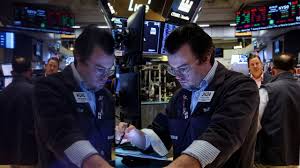Investor confidence took a dramatic hit on Monday as the Dow Jones Industrial Average dropped by 890 points, marking one of the steepest declines of the year. This market rout came after President Donald Trump hinted at a potential recession during an interview, fueling widespread fears and uncertainty among traders and industry leaders.
Unpacking the Numbers
The Dow fell by 2.08%, shedding 890 points. The broader S&P 500 and tech-heavy Nasdaq also saw significant declines, posting losses of 2.7% and 4% respectively. These figures represent the worst single-day performance for the Dow and S&P 500 this year, while the Nasdaq endured its largest drop since September 2022.
Adding to investor fears, Bitcoin suffered as well, sliding to its lowest value since November, with many considering the selloff indicative of broader uncertainty in riskier asset classes.
What Triggered This Market Chaos?
The catalyst behind Monday’s downturn was an interview President Trump gave on “Sunday Morning Futures With Maria Bartiromo,” where he refused to rule out the possibility of an upcoming recession. When asked whether investors should be concerned about an economic downturn, Trump cryptically described the current economic state as “a period of transition” and sidestepped offering reassurance.
This lack of clarity, combined with Trump’s recent implementation of erratic trade and tariff policies, sent shockwaves through Wall Street. Analysts already weary from months of tariff-related unpredictability were quick to peg Trump’s comments as the primary source of market anxiety.
“President Trump’s comments not necessarily taking a recession off the table unnerved investors who were already unnerved,” noted Anthony Saglimbene, chief market strategist at Ameriprise, emphasizing the market’s growing uncertainty.
The Role of Tariffs and Policy Uncertainty
Trump’s on-again, off-again tariff policies have placed an added weight on global trade and investor sentiment. These include:
- Doubling tariffs on Chinese imports to 20%
- Threatened increases in tariffs on lumber and dairy products from Canada
- Implementation of a 25% steel and aluminum tariff set to take effect in just days
This tariff talk has sparked uncertainty among businesses both domestically and globally. “The talk of tariffs is, in a lot of ways, worse than the implementation of them,” said David Bahnsen, chief investment officer at The Bahnsen Group. He added that this ongoing chaos could potentially hurt economic activity for at least a quarter or two before resolving through trade deals.
The Ripple Effect on Major Sectors
Certain sectors bore the brunt of Monday’s selloff, with technology stocks leading the decline. Collectively referred to as the “Magnificent Seven,” power players like Apple, Alphabet, Tesla, and Microsoft all closed in the red. Tesla, in particular, saw one of the most significant drops of the day, tumbling over 15% due to a mix of political controversies surrounding Elon Musk and weakening European sales figures.
The uncertainty surrounding trade and impending economic concerns also created spillover effects across industries. Delta Airlines issued a profit warning, signaling rising operational costs and lower demand. Cracks are also visible in other parts of the economy as layoffs rise, hiring growth slows, and consumer confidence erodes.
Investor Sentiment and Market Volatility
Monday wasn’t just about numbers; it was about fear. The CBOE Volatility Index (VIX), often referred to as Wall Street’s “fear gauge,” reached its highest level this year. Meanwhile, CNN’s Fear and Greed Index revealed that “extreme fear” is dominating market sentiment, reflecting the widespread anxiety over the uncertainty surrounding Trump’s policies.
Notably, the 10-year U.S. Treasury yield declined as investors sought safe-haven assets, signaling doubt about future economic growth.
Recession Fears Loom Large
The very mention of a recession can often become a self-fulfilling prophecy as markets begin to adjust based on expectations of economic stagnation or contraction. Economists point to several cracks in the current economic landscape that could deepen:
- Rising Inflation – With consumer prices still high, efforts to curb inflation may inadvertently stall economic growth further.
- Slowing Hiring – Job creation is beginning to lag behind forecasts, increasing unemployment concerns.
- Eroding Consumer Confidence – Rising fears over potential recessions often translate to reduced consumer spending, further slowing economic activity.
Currently, a recession is defined by two consecutive quarters of negative GDP growth, though exact outcomes are hard to predict. “How long this period of investor caution persists depends on how quickly it will take the global trade clouds and the resulting threat of recession to dissipate,” explained Sam Stovall, chief investment strategist at CFRA Research.
Looking Forward
Investors are waiting anxiously for key data points to determine broader economic trends. This week brings inflation data releases, which could shed light on whether inflation remains stubbornly high. These metrics will be critical in determining whether the Federal Reserve will maintain its hawkish stance or pivot towards easing monetary policies.
While the U.S. government continues to project optimism about achieving “historic” growth, the stock market’s response indicates a lack of confidence in Trump’s “America First” policies. Much will depend on how policymakers act to calm markets and reassure businesses.
Final Thoughts
Monday’s rout serves as a stark reminder of how quickly investor sentiment can shift when faced with uncertainty. The Dow’s near 900-point drop and broader market turbulence underscore the fragility of economic confidence amidst erratic policies and unclear messaging.
For now, all eyes are on the White House, as investors hope for concrete steps to stabilize trade relations and dispel recession fears. Without these measures, volatility may persist, leaving policymakers under even greater pressure to deliver decisive action.
Whether this “period of transition” becomes a long-term economic success story or the early signs of recession, one thing is clear—the markets are watching closely.








